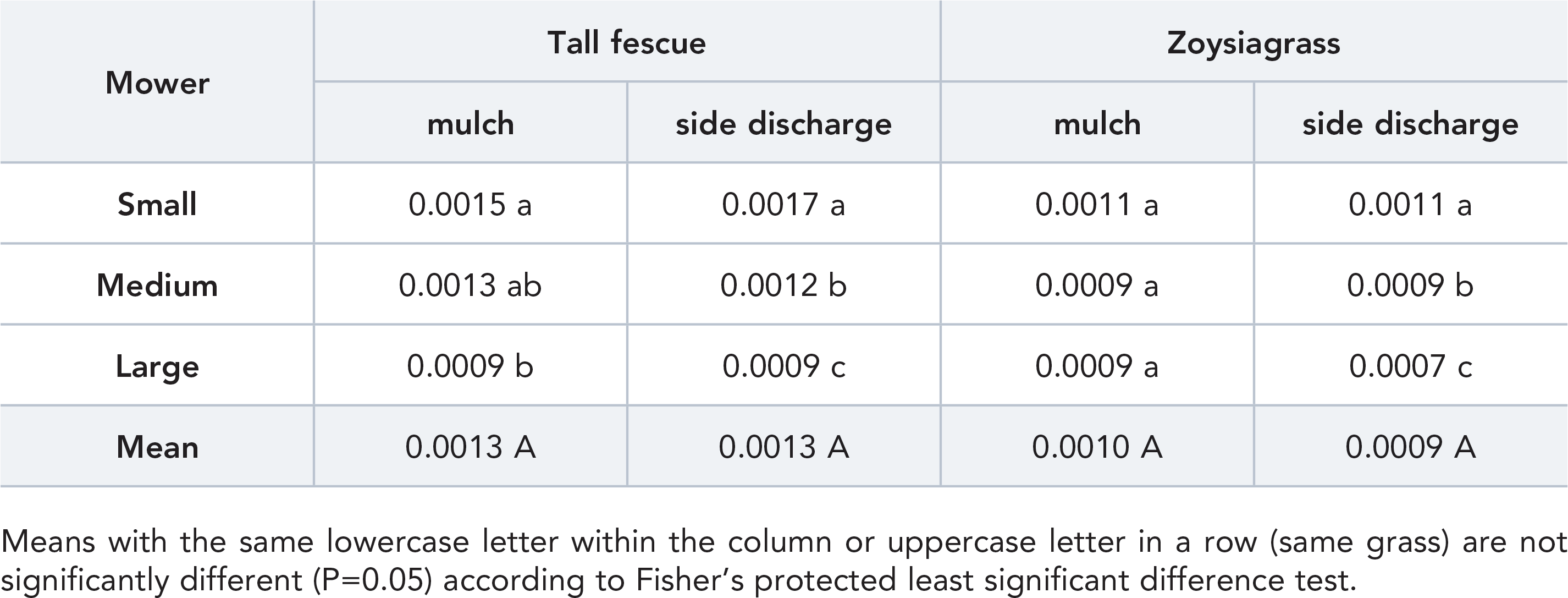
9 minute read
Cover Story
Are Mulching Mowers Necessarily Better?
By Grady L. Miller and Raymond K. McCauley
Introduction
Recycling lawn clippings promotes the retention of plant nutrients on site and may enhance turfgrass quality. It seems reasonable to assume that smaller turfgrass clippings will filter down through the turfgrass canopy to the soil surface and enhance the onset of decomposition and provide an environmental benefit. From a consumer’s perspective, fewer clippings visible on the turfgrass surface can result in a more uniform, attractive turfgrass canopy. It is this point that is often used as a selling point for using a specific mower or a method of mowing. But there has been no scientific study to show if one mowing method results in a higher quality turfgrass or not.
Rotary lawn mowers have decks that house one to three horizontal rotating cutting blades. The decks of these mowers are designed to lift, cut, and discharge leaf tissue through side or rear orifices. Many mowers offer a mulching option which closes discharge orifices resulting in completely enclosed decks. For some mowers, decks are mulching-specific. In principle, mulching-specific decks cut clippings multiple times before discharging the ‘mulched’ debris beneath the unit into the turfgrass canopy. This suggests mulching units should produce more visually appealing turfgrass stands as a result of fewer clippings on the turf surface immediately following mowing. Some of our previous work that evaluated cut quality of different mowers on multiple coolseason grass species and various mowing modes (mulching, side discharge, and bagging) resulted in inconsistent post-mowing turfgrass quality between various mower setups (Miller et al., 2016). Specifically, it was found that mulching units deposited excessive clippings on the turf surface and decreased turfgrass quality compared to side discharge units. However, this study did not compare clipping sizes from side discharge and mulching mowers but just assessed biomass on the surface. The objective of the study presented in this article was to evaluate the effectiveness of mulching mower operation to reduce clipping particle size compared to traditional side discharge mower operation.
Mowing Units
To accomplish this objective, a field study at the Lake Wheeler Turfgrass Research Laboratory in Raleigh, N.C. was conducted to assess the influence of mower setup on post-mowing clipping size. Each mowing unit was used on actively growing El Toro zoysiagrass maintained at 2.5 inches and tall fescue maintained at 3.5 inches. Turf species were chosen due to their popularity among North Carolina homeowners.

Three commercially available mowers were chosen for all testing to range all market designations from small homeowner to large commercial mower units: Recycler Lawn Mower with a 22 inch cut diameter (Small), Commercial Walk-Behind Mower with a 36 inch cut diameter (Medium), and a Zero-turn Commercial Riding Mower with a 52 inch cut diameter (Large) (Table 1). Mowers were pretested to align their effective cutting heights within each turfgrass, and each mower was operated at three miles per hour during testing.
Table 1. Mower engine horsepower, engine speed, blade configuration, and measured bench mowing heights for all mower treatments on zoysiagrass and tall fescue.

Turf Clipping Collection
Post-mowing clipping size was measured for each mower at sidedischarge and mulching modes. Prior to mowing test plots, two one-square-foot areas were pre-marked within each plot. Premarked areas were allowed to dry, mowed, and then vacuumed to remove debris. For the mulching mode, tissue was collected within the mower deck path and on the edge of the mower deck. For the side discharge mode, samples were collected within the mower deck path and within the side discharge area of clipping dispersion. Fresh-cut clippings were immediately placed in sealed plastic bags, preserved on ice, and transported to a lab where they were analyzed within three hours of collection.
Clipping Size Analysis
A computer particle analyzer was used to quantify clipping particle length and area. Previous research found the particle analyzer to be >97% accurate in both particle counts and dimensional measurements. The target number of clippings for analysis was at least 30,000 particle counts. In this study, turfgrass clipping counts for each plot averaged 44,180 for all the samples analyzed—56,814 for zoysiagrass clipping particles, and 31,546 for tall fescue particles. In addition to counting the clipping particles, the average particle length and specific projected area of clipped turfgrass particles were determined for each sample. The specific projected area of clipped turfgrass particles measures the average size of the clippings regardless of their shape.
Treatment Effects on Clipping Length and Specific Projected Area
Each of the three test factors—mower size, mowing mode, and turfgrass species—influenced clipping length. Interestingly, clipping length was influenced by mower and mode of mowing but not their interaction. In other words, the smaller, medium, and large mowers responded the same relative to the mode of mowing.
The specific projected area of clippings was less influenced by treatments compared to clipping length. While both mower and grass species influenced clipping specific projected area, the mode of mowing was not a significant factor, nor was there a mower x grass interaction. The location of collected clippings in relation to the mower deck was not originally considered to be important, but an evaluation of whether clippings were collected at the edge of the deck or underneath the deck indicated a large influence on both clipping length and area.
Measured Post-Mowing Clipping Length
The premise behind a mulching mower is that clippings stay under the deck longer so that the spinning blades can make multiple contacts with the plant tissue, further reducing the tissue particle length/size. This was not the case with tall fescue post-mowing clipping length. Tall fescue clipping length was 20% longer when mulched compared to side discharge (Table 2). No differences in clipping sizes were noted for zoysiagrass clippings when comparing mowing modes.
Table 2. Average length of collected turfgrass leaf tissue (in) as a function of grass, mowing mode, and mower. Values represent a mean of six samples (three replications from two collection points).


Using the small mower on tall fescue resulted in longer clippings compared to the medium and large mowers regardless of mode. The medium mower reduced zoysiagrass tissue length compared to both the small and large mowers in mulching mode but similarly to the large mower in side-discharge mode. The slower blade speed of the low-power, small mower is most likely the reason it did not reduce clipping length as effectively as the larger mowers. Furthermore, the dense zoysiagrass canopy may have moderated the effect of mower performance.
The sample collection location in relation to the mower deck further illustrates the importance of deck design in regards to clipping size. Tall fescue clippings collected at the deck edge were nearly 85% longer following mulching. This suggests clippings from the deck edge were not coming in contact with the mower blades at the frequency of clippings collected from underneath the deck. Longer clippings deposited along the deck’s edge can result in a clumping appearance across the turfgrass surface, reducing surface uniformity of the mown turfgrass. Zoysiagrass showed minimal differences in clipping length for the two collection points.
Specific Projected Area of Clippings
Post-mowing turfgrass tissue length is important for turfgrass aesthetics since tissue of greater length may be more likely to remain on the surface and reduce turfgrass quality. However, the specific projected area of the tissue likely influences the rate of decomposition more than tissue length. The specific projected area decreased with increasing mower size for side discharge (Table 3). This is likely the result of increased mower blade speed. The specific projected area decreased from 19 to 32% as mower sized increased. There was a trend in decreasing specific projected area in the mulch mode for tall fescue similar to those measured in tall fescue side discharge. There was no change in specific projected area for zoysiagrass clippings due to mower size operating in the mulching mode.
Implications of Mower Setup
In summary, the two measurements of clipping size—length and area, were evaluated for three mowers of varying size using mulching and side discharge modes on two turfgrass species. The test hypothesis was that mulching would reduce clipping size. The results indicated that mulching did not decrease clipping size, and in one instance resulted in longer clippings. The turfgrass species and mower size had a greater impact on clipping length and specific projected area than mode of mowing. Our results, combined with previous data which indicated mulching mowers resulted in greater clipping deposits on the surface, suggest that a mower used in a mulching mode of operation may leave longer clippings on the turfgrass surface that could reduce decomposition rates and visual turfgrass quality. This does not mean that using a mower in the mulching configuration is bad, since the clipping are staying on the site. But in our experience, the distribution of clippings over a larger area from side discharge provided a higher-quality appearance of the turfgrass.
Table 3. Specific projected area (in2) of total turfgrass leaf tissue pieces collected as a function of grass, mowing mode, and mower. Values represent a mean of six samples (three replications from two collection points).

Reference
Miller. G.L., D. Pinnix, and G. Grabow. 2016. Evaluation cut quality testing methods for consumer lawn tractors. ASA, CSSA, and SSA International Annual Meetings. Phoenix, AZ. P 99947.
This research article is intended for educational purposes. Further comprehensive information can be accessed in our original publication in Crop, Forage & Turfgrass Management (https://doi.org/10.2134/ cftm2019.06.0050).










